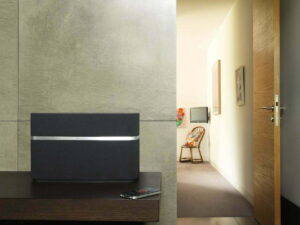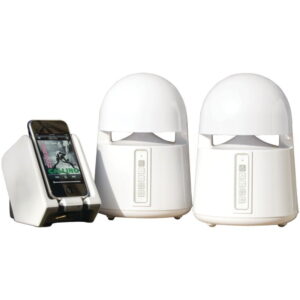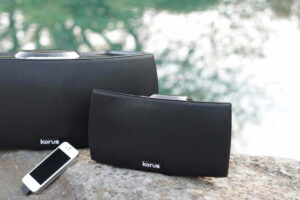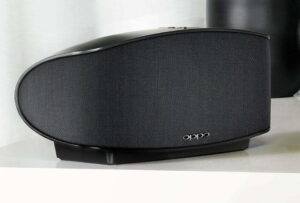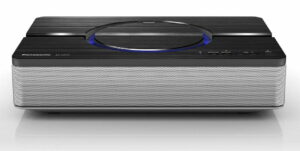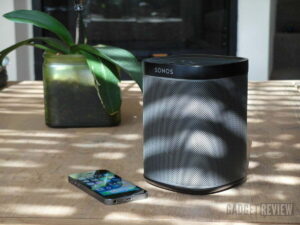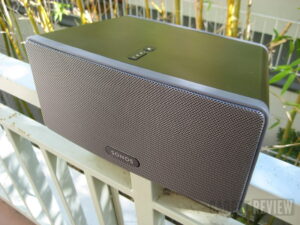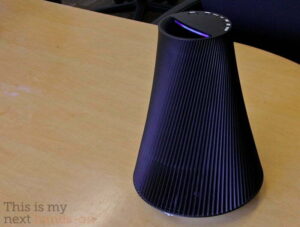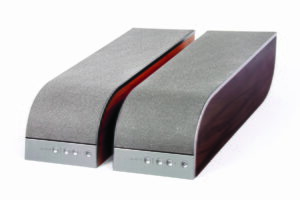I’ve been a SONOS user for the better part of 3 years (based on my hands-on experience, it’s one of the best wireless speaker systems money can buy). My experience with SONOS includes both a handful of Play:3 speakers and the Connect box – the latter plugs into an existing speaker system, though there is a powered version that will support just a set of speakers. This is why I’m happy to provide my latest SONOS Play 5 review. If you’d like to see a more intense speaker system, take a look at our Audioengine N22 Desktop amplifier and P4 passive bookshelf speaker review.
The company has come a long way in the last 3 years, renting a studio (the SONOS Studio in Hollywood), slapping up billboards, and even advertising alongside NFL playoffs. If the last one doesn’t say success (in the retail market), then I don’t know what does.
It wasn’t too long ago that they introduced the Play:1, a diminutive sized speaker designed to be placed in the bathroom or kitchen – it can resist moisture – or anywhere you deem. They also unveiled, not too long ago, the Playbar, a solid wireless soundbar. And now the company has unveiled an all-new Play:5 speaker, right on the heals of TruePlay, a new technology introduced by the company that uses your phone’s microphone to optimize the sound of any one of their stand-alone speakers.
Overview
Price: $499
Available: September 28, 2015
Summary: The Play:5 is SONOS’ best speaker to date, if not the best wireless speaker money can buy on the market today.
What We Liked:
- Crisp clear sound with thunderous bass for its size
- Easy setup
- Excellent design and packaging
What We Didn’t:
- More pricey than the last Play:5; $100 more
- No Bluetooth or Airplay connectivity
What’s Different: Play:5 Gen 1 Vs Play:5 Gen 2
I don’t remember when the first Play:5 hit the market, but I did review it, though in a somewhat uneducated fashion; I didn’t realize the true power of SONOS. But to my credit, SONOS, at the time, hadn’t streamlined their product line or branding. That being said, the Play:5 of today, the second-gen Play:5, boasts the same amount of speakers (3 mid-woofer and 3 tweeters) as the last, though the company has added an amp, going from 5 to 6.
SONOS has also updated the design of the Play:5, offering a much sleeker and solid package, that has now been adorned with touch-sensitive buttons. In fact, it’s more analogous in form to that of the Play:3 in that it’s one singular box and no longer sits on a pedestal. It’s also not one of the leading smart speakers, but it does have its benefits.
Play:5 Gen 2 Design
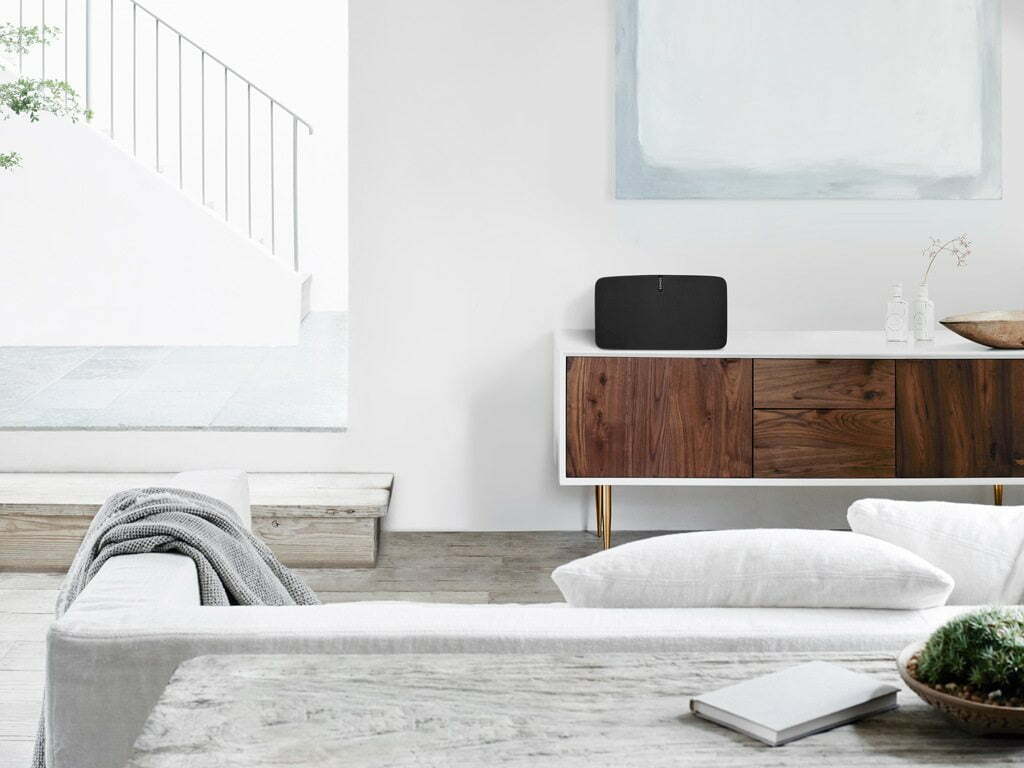
This Play:5 is better looking than the last. Bar none. No way around it. Gone are the tactile buttons to play/pause music or adjust the speaker’s volume. They’re now replaced by touch-sensitive buttons, making the facade of the Play:5 that much cleaner.
Once again, just like the Play:5 of the past (and the Play:3), this version is available in black or white. However, the grill color, black, remains the same regardless of what color you choose. I find this to be an annoyance, especially since most will opt for white in the hopes of blending in with the background.
In the hand, the second-gen Play:5 is solid and is, by all means, a “tight package”; not an ounce of flab on this thing. Or in other words, it doesn’t feel like SONOS skimped in manufacturing. Actually, with more thought, they’ve vastly improved their cabinetry, offering what appears to be a sealed box; There are no longer seams that run the perimeter of the speaker. This is good, because you want a speaker with a tight cabinet as it can cut down on resonation and rattling, and in turn, improve sound quality.
Turning the back, there is the in-line audio jack for those looking to go old school, an Ethernet port, as well as a pairing button which is used for initial setup.
Setting Up the Play:5
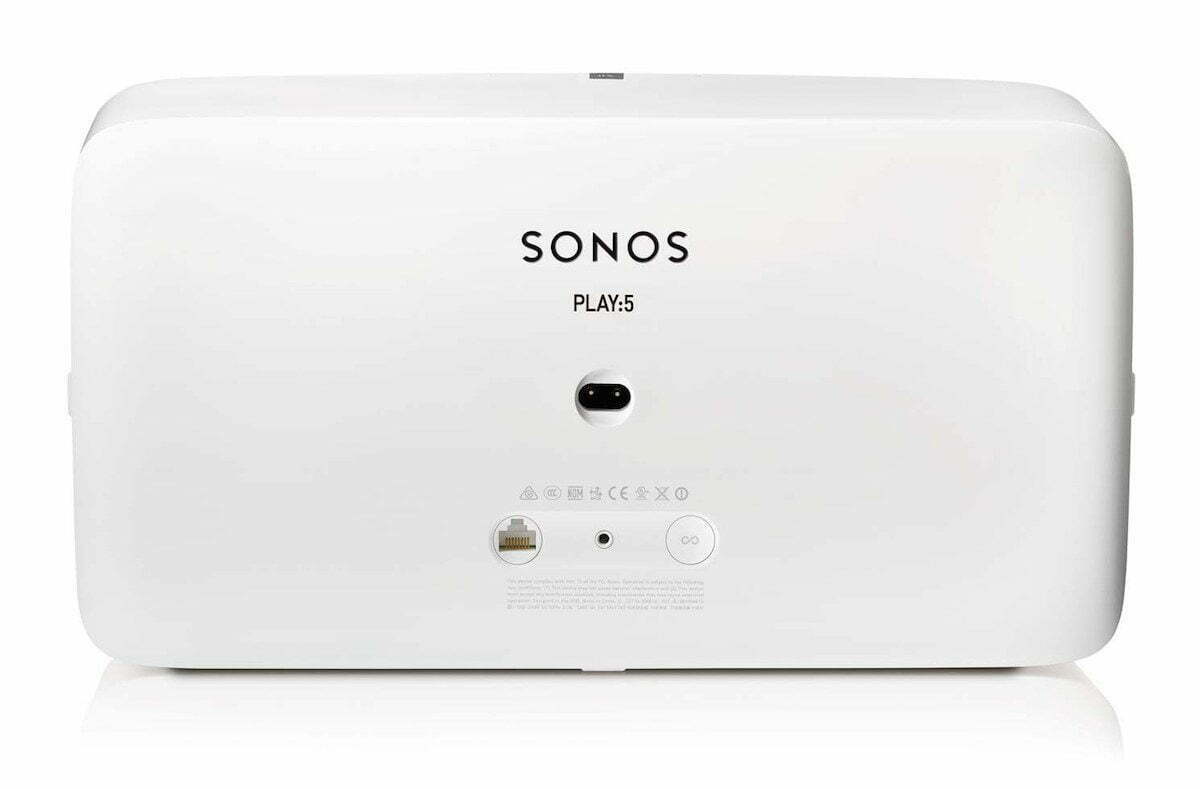
In the beginning, and not until too long ago, for SONOS to function, you needed a SONOS Zone Bridge. It plugged into your home’s router and in turn distributed the necessary wireless signal to any accompanying SONOS speakers. But not anymore. Now, you can connect your SONOS speakers directly to your home’s WiFi. However, for the best, or perhaps optimal experience, one should still grab a SONOS Boost (this is in effect a Bridge) as it creates its own wireless network. This is great, considering the Razer Ferox only uses a 3.5mm jack or USB to play music.
Alternatively, you can physically plug any of your SONOS speakers into your router via the Ethernet plug and thus create the equivalent effect of the Boost, though perhaps without as much signal power.
Because I’ve long used SONOS, my setup was simple, quick, and painless. All I had to do was plug the Play:5 into a power socket, open the SONOS app, go to Settings, and add a new component. The app then walked me through the process, and told me to hit the pairing button on my Bridge, and presto, the speaker was available for streaming. And yes, it is that easy, provided you already understand how SONOS works.
For those with deeper pockets, and can afford two purchases and place two Play:5s in one room, there is a stereo feature, which allows you to pair two Play:5s together and create a larger, more realistic sound stage. To that end, the Play:5 can be placed on any one of its ends, and the speaker will automatically adjust its sound and the volume buttons according to its orientation.
The SONOS App
The SONOS app has gone through a few iterations over the last few years. And it would seem that they’re pushing more updates than ever before. Good? Yes, especially when they roll out new features. Bad? Sometimes, the new features don’t always work right, or the updates don’t take, which has been my experience on the Android.
That said, the SONOS app is available for Windows, Mac, Android, and iOS. It’s been a while since I’ve used the Android version of the app, but I’ve always found the iOS version more polished and less buggy.
The app, while not the most intuitive, does get the job done. This is to say that SONOS has some work to do to make things more in line with today’s mobile apps; the experience could be more fluid.
For instance, switching speakers feels a bit laborious, and jumping to a different source of music – Spotify to Pandora – requires stepping back a few times and then going forward a few more. And as many times as I’ve used the app, and for long as I have (years), locating the alarms and sleep settings is never intuitive. Never. But yes, both of those features do exist, and waking up to music has never been easier.
That being said, there are a variety of music services that work with SONOS. This includes, but isn’t limited to Spotify, Pandora, Hype Machine, Tune In (for local radio), and more (the full list Bluetooth). And for those that want to play music via their iPhone, you can do that too.
Play:5 Sound Quality
Put simply, this is the best Play:5 yet (it’s also the best SONOS speaker to date). Sure, there have only been two Play:5s, but you get my point; this one sounds better than the last. The Play:5 has a fairly vast range, producing exceptional highs and booming lows. So much so that I had to make sure I wasn’t playing music through my home theater system. Shocking, because the Play:5 is fairly compact.
Now, granted, sound quality is only as good as your source. In my case, I tested a variety of music genres using Spotify, which offers a fairly high-quality stream. I also made sure that, within the Advanced Settings menu, I had selected “uncompressed audio”. For those who perhaps have bandwidth issues, you might want to select “Auto”, but it’s never an issue in my home, which has anywhere from a 10mbps to a 50mpbs downpipe.
If you desire a bit more boom in your music, there is a “loudness” setting, which will boost the lows at a lower volume. It’s a useful feature, especially if you want your music to have a bit more punch at a lower output. As you increase the volume of the Play:5, things will begin to equal out. Push the volume more, and much like other speakers on the market, the Play:5 will begin to reduce the lows to reduce distortion, or a degradation in the sound quality, at least as far as my ear could tell. But keep in mind that this will depend on the type of music you’re listening to.
Play:5 vs Play:3
To SONOS’ credit, this Play:5 is brand new. Whereas the Play:3 is a few years old, so suffice to say, it’s not their latest and greatest.
Now, it’s not a fair competition, as the Play:5, regardless of generation, has always had more speakers and power under its hood. But sonically, if you will, a single Play:5 will outperform two Play:3s any day of the week. The Play:5 offers more gusto, oomph, and all-together range than the Play:3.
Moreover, its design is more polished and altogether feels higher quality. And with more thought; it’s almost as if this second-gen Play:5 came from another company. This might be a fair assessment based on how far SONOS has come in the last 3 years. So if you’re debating between a Play:3 or a Play:5, and price and size are moot, definitely go Play:5.
SONOS Trueplay
Truth be told I haven’t spent much time with Trueplay. It was rolled out in the last few months and is a fairly unique offering, especially for those who want to put less thought into their speaker placement. Which is to say, Trueplay automatically fine-tunes the Play:5 (also compatible with the Play:3 and Play:1) for optimal audio, offering what SONOS calls “a spot-on playback”.
How does it work? Within the SONOS app, you simply head to Room Settings, then select the speaker (if you have more than one in your home) that you want to tune. The app then utilizes your iPhone or Android’s microphone to measure the room and determine how the Play:5 should be tuned. During the tuning process, you’ll need to ensure the room is fairly quiet, as the Play:5 will emit a tone during the 30-45 second process. It’s easy to perform and SONOS has even included a simple-to-follow video during the process.
Does it make a difference? I need to complete more testing before I can say one way or another.
Play:5 Pricing and Final Thoughts
This Play:5 is $100 more than the last, costing $499. For that price, you get 6 drivers, a set of dedicated amps, and of course wireless audio, save for the fact you need a power outlet within an arm’s reach. Setup is simple, though I could see how some consumers won’t immediately grasp the benefits of SONOS over Bluetooth speakers or Airplay.
And to be quite honest, if you only seek a single speaker step, SONOS might not be a fit for you. But I think after you spend some time with a SONOS speaker, even if it’s just a Play:1, you’ll realize how much better the experience is than some of the best Bluetooth speakers or Airplay speakers. Which includes:
- SONOS is its own music server; you don’t need to have a mobile device connected for music to playback
- You can add multiple speakers, over 30, and playback a different source of music through each one
- Multiple people can collaboratively control the music experience
- All you need is a phone, computer, or tablet to control the music; no dedicated remote needs (or wanted, ever)
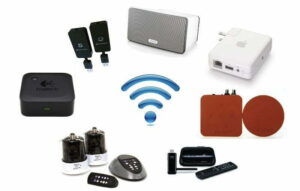
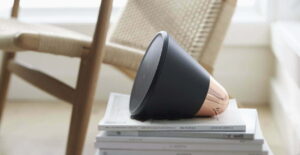
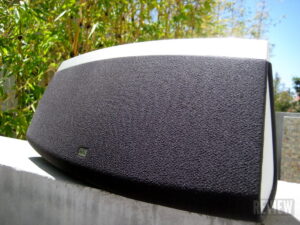


![Best Wireless Speakers in [year] 6 The top wireless speakers - not Bluetooth.|A top wireless speaker from sonos](https://www.gadgetreview.dev/wp-content/uploads/best-wireless-speaker-300x169.jpg)
